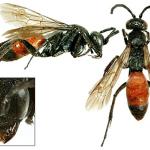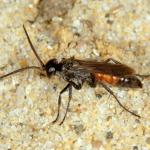One of our most frequently encountered red and black spider-hunting wasps, perhaps because it spends a lot of time searching open sunny ground for nesting host species.
This species is widely distributed throughout the British Isles, with only a few records from north of Yorkshire. There are several records from Ireland (Wexford and Wicklow).
Widespread in northern and central Europe, and in south European mountains. Also occurs in Central Asia and the Nearctic (Wolf 1972).
This species is not regarded as being scarce or threatened.
Day, 1988 is the standard work for identifying British Pompilidae. Wiśniowski, B., 2009 is also useful.
Although most often encountered in sandy habitats (Day 1988), this species may be found on areas of open ground within many different habitats.
May to September (Day 1988).
This is a cleptoparasitic species probably preying on various species of Arachnospila, although specific hosts have not yet been identified. Day suggests Arachnospila anceps and Anoplius nigerrimus as hosts in the British Isles. There is a continental record of Arachnospila trivialis being parasitised (Day 1988).
Visits a wide variety of open flowers with short corollae, especially those of the families Apiaceae and Asteraceae.



